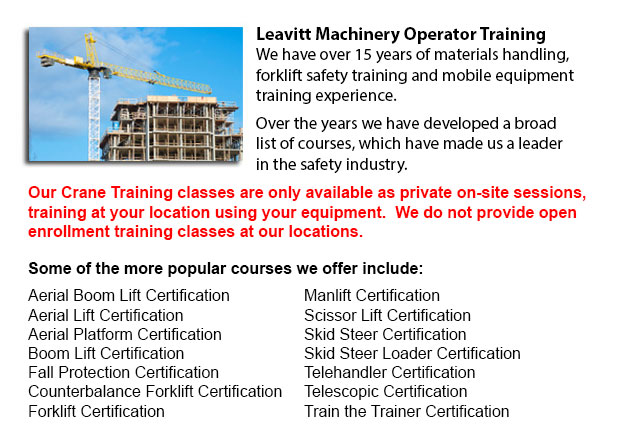
Overhead Crane Safety Training British Columbia - Overhead crane safety training equips operators with skills and knowledge about crane safety precautions, materials handling, accident avoidance, and machinery and stock protection. Trainees would learn the kinds of overhead cranes, their capabilities and their uses in various industry environments. For operators who are trained and licensed, the shift in liability moves to the operator from the company. Therefore, the course emphasizes individual operator tasks.
Overhead crane safety training instructs operators in the correct techniques for performing checks. Two kinds of pre-shift check are the in-depth inspection and the walk-around inspection. These are vital daily routines that should be logged. Correctly recorded pre-shift checks help to protect the business from liability in case of an accident. Pre-shift inspections also prevent expensive repairs, accidents and damage. Operators learn how to designate a particular person to handle checks, how to report problems, and how to maintain the log book.
Checks must be done on a regular basis and documented correctly. The following should checked while watching for common problems: hooks for cracks, increases in the throat opening, hoist ropes for corrosion, degree of twist, loss of diameter, worn wires, bird caging and kinks, broken wires, chemical and heat damage; chains for gouges and nicks, corrosion and cracks, twists, distortion, excessive wear, pits, stretching, damage from extreme heat.
The operator would get to learn the correct ways regarding right rigging procedures. The process of rigging includes the understanding of the manufacturer's data plate, determining the weight of materials to be lifted, choosing the gear, and using safe practices to secure the load. The program include in detail the following: safe working loads, and the capacities of chains, ropes, hooks, shackles and slings.
It is vital to know who could operate the cranes at your facility, the job's physical requirements, and operator credentials required for permits and specialized job. Safety is a top priority when utilizing near pedestrian traffic.
Safe crane operation consists of duties like for example checking for hydraulic leaks, undertaking visual inspections, testing the controls, checking the safety guards, examining the hook and hoist rope, braking mechanisms and limit switches. Right reporting methods are critical. These subject matters are all included in depth in the program.
The course also includes the proper moving and lifting methods with cranes and hoists. Operators will likewise learn right hand signals. Training involves how to attach the load, raise the load, unhook the slings, abort a lift and set the load.
The steps involved with moving the load, consists of: starting and stopping procedures, controlling and guiding the load, working with signals and observing working conditions. In the event of power failures, the operator would need to know how to proceed. The program includes methods for removing the slings and lowering the load, storage of equipment, parking the crane, and securing an outdoor and indoor crane.
-
Warehouse Forklift Safety Training British Columbia
Warehouse Forklift Safety Training British Columbia - The corporation would face claims for liability when damage and injuries are sustained in an accident at the workplace. Warehouses can be a hazardous place to work for its workers, making employee... More -
Loader Operator Certification British Columbia
Loader Operator Certification British Columbia - Courses Offered For Getting Loader Operator Certification - Certification for forklifts are required to guarantee the safe operation of forklifts for those employers in industrial, warehouse or constru... More -
Crane / Overhead Crane / Self-Erect Crane / Truck Mounted Crane / Hydraulic Cranes Training in British Columbia
Bridge cranes or likewise called overhead cranes are actually a type of industrial material handling crane making use of a line and hook device that runs on a horizontal beam running along two widely separated rails. Numerous overhead cranes could be... More -
Scissor Lift License British Columbia
Scissor Lift License British Columbia - The operation of scissor lifts carries an inherent chance of danger. Whichever type of powered machine requires correct handling to prevent accidents causing injury or damage. Companies need to make certain tha... More -
Heavy Equipment Training Schools British Columbia
Heavy Equipment Training Schools British Columbia - There are a lot of heavy equipment training schools to select from. If you want to get to the best, it is important to check various aspects of the school in order to ascertain the level of educatio... More -
Telehandler Training British Columbia
Telehandler Training British Columbia - Telescopic handlers usually called telehandlers for short, are an extremely popular piece of heavy construction equipment. They are commonly utilized in the construction and agricultural trades. These machines... More -
Forklift Training Courses British Columbia
Forklift Training Courses British Columbia - When forklift operator safety training is tailored for illiteracy, training time is lessened by 50%. Forklift training certification, lift-truck operator driver safety training evaluation, and train the tr... More -
Heavy Equipment Operator Training British Columbia
Heavy Equipment Operator Training British Columbia - Heavy equipment operator training facilities which provide quality standards in the business, providing field performance work and added machinery training are highly sought after training features... More

Forklift Training British Columbia
TOLL FREE: 1-888-254-6157
forklifttrainingbritishcolumbia.com
Email Us
About Us


